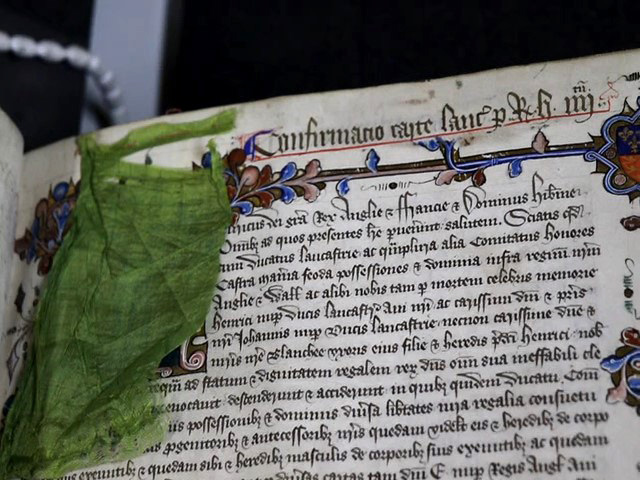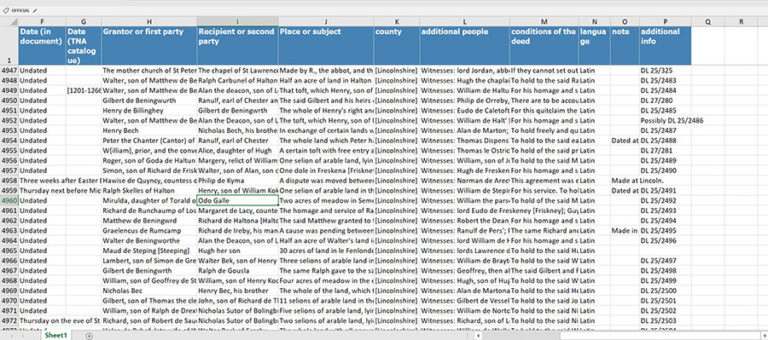Medieval specialists at The National Archives have been developing a major research project on the estates and people linked to the duchy of Lancaster. Titled ‘A State Within a State? The making of the duchy of Lancaster c.1265-1422’, the project is led by academics at Lincoln and Lancaster universities and also involves heritage professionals in Lincolnshire and Lancashire and staff at the duchy of Lancaster headquarters. The project was outlined in a recorded presentation during last year’s Catalogue Week. This blog builds on some of the discoveries as the project has progressed.

A key starting point in looking at the duchy landscapes and communities over time is the Great Cowcher book (DL 42/1 and DL 42/2). This is a deluxe, illuminated register of evidences of title to the duchy lands. It was commissioned by King Henry IV after he took the throne in 1399 – it is second only to Domesday Book among The National Archives’ treasures in its importance as a survey of English and Welsh landholding and lordship.
The chief officers of the duchy, headed by receiver general John Leventhorpe, compiled the book by the end of 1402 by bringing original records from duchy manors and estates to dedicated offices, probably at the Savoy Palace just outside London’s walls. Around 5,000 documents were eventually copied into the Cowcher and now provide amazing detail on the range of duchy lands and landscapes, their governance and regulation, and on the people who lived and worked upon them.
Thanks to financial support from the Friends of The National Archives and the excellent work of researcher Simon Neal, the entire contents of the Cowcher books have now been summarised in spreadsheet form ready for use by the project and eventually as data for The National Archives’ catalogue. Linking the Cowcher entries to original deeds and other manorial documents that survive among the DL series deposited by the duchy at The National Archives reveals patterns and clusters of records that were not obvious before the contents of the Cowchers were converted and analysed in digital form.

These past collections of documents reveal in their annotations and cross-references some evidence of how the records were used in the past. The duchy created many registers and record surveys to help organise the masses of documents that remained essential for estate management histories of occupation of lands. This was an ongoing process and was linked to the movement of the duchy archive through various sites before it came into the Public Record Office’s custody.

In this image, in Bag B, press 26 upper, we have evidence of covenants, charters, manorial surveys, a dower agreement by Edmund Mortimer, manor court records, warrants, a coroner’s inquest, a report on an inspection of earlier records, an exemplification of Domesday and record of a woodsale – various dates and various counties are given consecutive numbers in the register. This type of evidence is important in working out provenance and the evolution of archival classification of the records.
Another collection with a very interesting archival relationship to the Cowcher and other compendia such as the Cartulary of Furness Abbey (DL 42/3), are the charters and other records assembled in the first three volumes of series DL 36. This is the duchy’s miscellaneous charters – Cartae Miscellaneae. The first volume represents records linked to the de Bohun family inheritance. We can assume that this archive came into Henry of Bolingbroke’s possession at his marriage to Mary de Bohun in February 1381. Volume 2 is closely linked to the de Lacy possessions in Lancashire. Volume 3 contains a more miscellaneous collection from these two great inheritances, including also papers of the hospital of St Mary Magdalen in Preston. Most interestingly, large parts of this collection do relate to the records deposited in the four Lancashire religious houses of Furness, Cartmel, Burscough and Cockersand.

[Endorsed] – Cyrograffum Ranulfi de Dak / 23 / lxxxvj.
The dorse number sequences relate to the arrangement of collections within the abbey. This record is copied into the Furness Abbey Cowcher, DL 43/3.
Various sequences were disrupted by changes in arrangement over time and the most recent and final mounting of the documents in boarded files (itself perhaps 170 years old). The endorsements also provide information on earlier arrangements. As part of the mid-19th century effort at the Public Record Office to sort papers and create record series, some identification of original records inked to text in the Cowchers was made. This becomes much more visible now that we have a digital summary text and the results of the project’s systematic search for the corresponding original document within other DL deeds or miscellanea series

Finis Alani de Waldesef et Adeline uxoris sue de maneriis Scheneleye in comitatu Essex’ et Lachebrok in comitatu Oxon / l4/ viij / ultima scribitur.
This final concord between Adam Waldesef and Avelina his wife, and Edmund, brother of the King, for the manors of Shelley, co. Essex, and Lashbrook, co. Oxford, 14 Edward I, is transcribed on DL 42/2, fol. 229, no. 8 – the eighth document in the Herts and Essex section.
Identifiable clusters of family estate papers are also linked to a specific estates or lordships later absorbed by the duchy. One example is an extensive series of deeds linked to Saltfleetby in Lincolnshire and the Galle family who lived on the same parcels of land through the late medieval centuries.

[Endorsed]:- lxxxx Scribitur.
This endorsement leads to charter number 90 in the Cowcher Book sequence for Bolingbroke Honour – DL 42/2, fol 462, no. 90.
Other sections of the Cowcher books are likely to reveal similar groups of related records. The great news is that the project is now able to sift this data to spot the clusters more easily. This will help to focus attention on duchy sites and estates with a deep range of evidence, around which we can readily structure other work. The project will build on this to analyse the role of the Cowcher and duchy archives in managing the late medieval estates; how this contributed to the evolution of the duchy’s administration as part of government in England and Wales; and how the detailed content of these records reveals local responses to changing economic, environmental and social conditions.